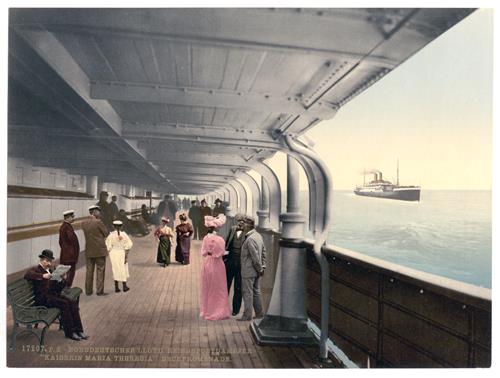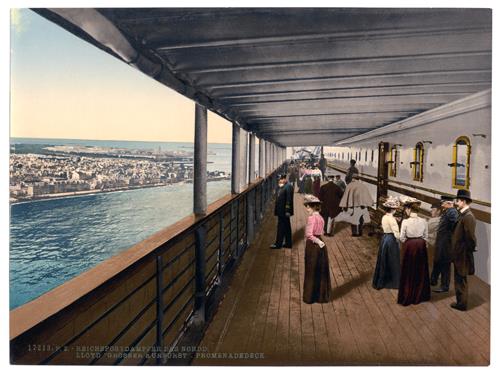Learning to Walk on a Steamship

Passengers Walking on the Promenade Deck on the SS Kaiserin Maria Theresia of the Norddeutscher Lloyd, 1890. | GGA Image ID # 17b54c359f
GETTING THE "SEA LEGS"
Landsmen are often joked by mariners, ancient and otherwise, about their "sea legs," but with a little care, however, it is possible to find one's "sea legs:" in fact, it is much easier than learning to dance. Select some sheltered corner of the deck for practice, where there is an absence of a breeze.
A long quiet roll is the simplest motion on the whole to overcome. When the ship rolls and pitches alternately, the problem is vastly complicated.
It will be readily understood that any permanent upright object on the deck of a vessel will be tilted or listed to an impossible angle as the ship rolls.
Naturally, the only way such an object can maintain its equilibrium is for it to change its position to remain perpendicular despite its base position.
The whole trick of keeping one's sea legs consists of keeping the body as nearly to a perpendicular position as possible, without regard for the angle of the deck beneath.
When the ship rolls, as it were, away from one, the body must be thrown in the opposite direction to maintain the balance. As the ship comes back, the body should be swung over to the other side.
The body, in short, should swing like a reversed pendulum. As the ship's deck falls away from the horizontal, the tendency will be for the body to go in the same direction.
The ordinary landlubber who is taken off his guard by such a motion involuntarily takes a step, or it may be a plunge, in the direction the ship takes.

Passengers Mingle on the Promenade Deck of the SS Gorsser Kurfurst of the Norddeutscher Lloyd, 1899. | GGA Image ID # 17b578deb4
The scientific thing to do is obviously to throw one's body in exactly the opposite direction. There are several ways of doing this. One is to maintain his equilibrium by bracing the body with either foot.
The beginner will brace himself by sticking out his foot to the high part of the deck. The plan, however, is awkward and calls for more effort than any other. The old salt braces himself from the other side easily and without, as a rule, changing the position of his feet.
It will be well for the beginner to practice this single step like a figure in dancing until it has been quite mastered before making any more ambitious attempt. Of course, it will be found much easier to practice standing with the ship pitching before trying to walk.
The whole trick is in maintaining one's balance easily and without effort. The rest will come naturally. The first lesson, it will be seen, seems ridiculously simple, but the difference between the theory and practice is great and can only be mastered with much practice. If the ship has much motion, the exercise will be found to be downright hard work.
The sailor stands easily and firmly. His feet are braced against the motion of the ship, but from long practice, he balances himself so easily that there is no suggestion of effort in his pose.
In maintaining his balance in this way, the old salt rarely changes the position of his feet. An interesting object lesson may be had, for instance, when the officers take the sun or make other observations in rough weather.
No matter how violently the ship rolls or pitches, a sailor will stand without moving his feet while he makes such a reading.
A sailor again will scorn to hold on to anything, and yet his position is absolutely secure. The explanation is very simple. The body is balanced entirely from the knees. This is, of course, an advanced stage of the art and comes only after long practice.

Passengers Getting Their Sea Legs on the Promenade Deck of the SS Konig Albert of the Norddeutcher Lloyd, 1899. | GGA Image ID # 17b5865c94
